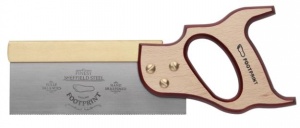Backsaw: Difference between revisions
From DT Online
mNo edit summary |
mNo edit summary |
||
| Line 7: | Line 7: | ||
|- | |- | ||
| '''[[Dovetail Saw]]''' | | '''[[Dovetail Saw]]''' | ||
| - similar to a Tenon Saw but shorter at 150mm to 250mm with finer teeth at 14 to 18 ''[[Teeth per Inch|TPI]]'' and used for finer work such as cutting | | - similar to a Tenon Saw but shorter at 150mm to 250mm with finer teeth at 14 to 18 ''[[Teeth per Inch|TPI]]'' and used for finer work such as cutting '''[[Dovetail Joint|Dovetail Joints]]'''. | ||
|[[File:DovetailSaw.jpg|250px]] | |[[File:DovetailSaw.jpg|250px]] | ||
|- | |- | ||
Revision as of 16:37, 18 February 2016
Backsaws have a stiffener along the top edge which helps to keep the blade straight and allows for closer control and fine work.
| Tenon Saw | - the most common backsaw, typically 250mm or 300mm length with 10-14 teeth per inch (TPI) and used extensively for general woodworking and fine cutting of joints such as tenons. | 
|
| Dovetail Saw | - similar to a Tenon Saw but shorter at 150mm to 250mm with finer teeth at 14 to 18 TPI and used for finer work such as cutting Dovetail Joints. | 
|
| Gent's Saw | - or Fancy Backsaw - typically 150mm long with very fine teeth (16 to 25 TPI) and used for very fine cutting of mouldings and inlays for example. | 
|
| Razor Saw | - commonly approximately 125mm long interchangeable blades with extremely fine razor sharp teeth (i.e over 50 TPI) and used for fine work in balsa and plastics - e.g. modelling. |